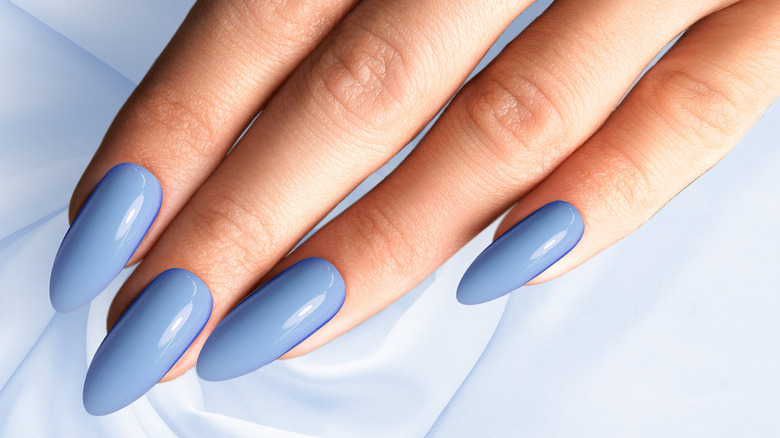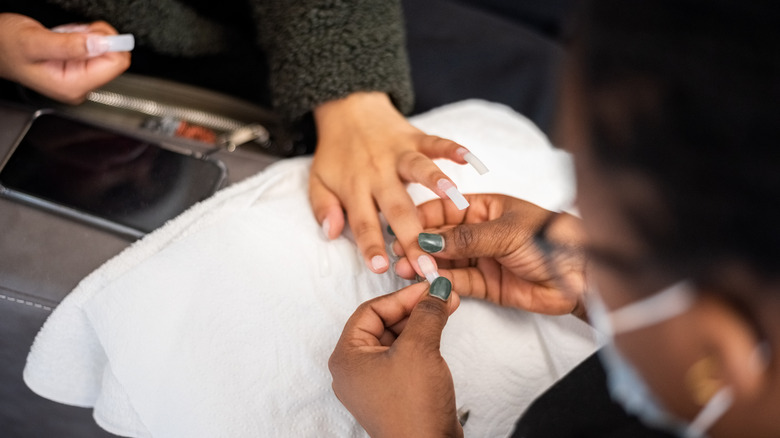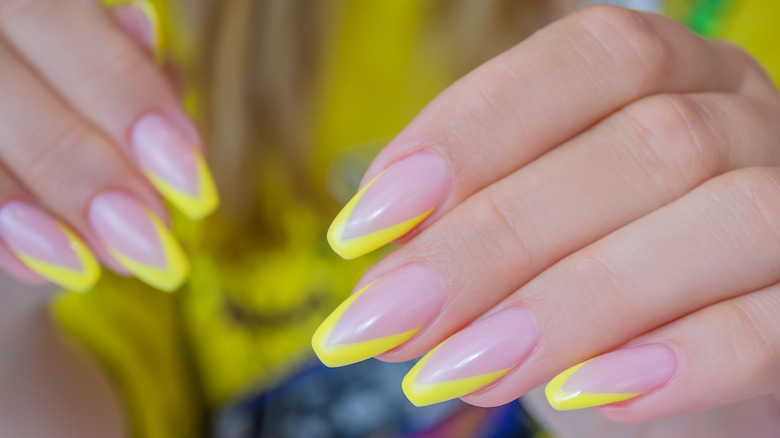What's The Difference Between Gel Extensions And Acrylic Tips?
Whether you like something more classic or are leaning into this year's hottest nail trends, you can find something you like among the nail designs that everyone is asking for, as they range from naked nails to chrome nails, textured nails, and satin nails. And while the design and colors may be different, a big common factor is the length and shape. Recently, nail techs began seeing an uptick in almond-shaped nails, something that has continued to stay on trend this year. It's important to know before choosing an almond shape that you need some length in your nails in order to achieve the look correctly.
This means that if you walk into your nail salon asking for almond nails while your nails aren't quite long enough, you have two options: You can either keep your original nails and settle for the more classic square or round shape or you can get gel extensions or acrylic tips. Both of these options are popular, but gel extensions are a newer option that many people are gravitating toward since they can be easier to apply, though acrylic options may be more sturdy. Not sure what the difference between the two techniques is or which one is best for you? We break it down for you.
The biggest differences between gel extensions and acrylic tips
Before you start changing up your routine, know that if you are getting your nails done by an expert, they will be beautiful and healthy regardless of which nail option you choose as both elevate your style. That being said, there are pros and cons to both gel extensions and acrylic tips. According to nail artist and gel extension specialist Brittney Boyce, acrylic tips are harder and less flexible than gel extensions, via Allure. Gel extensions also better accentuate a natural look, while acrylic tips are often noticeably fake to anyone who understands nails. "Acrylics tend to be harder than gel. It's typically done by mixing a powder (polymer) and a liquid (monomer) to create that dough-like consistency that can then be filed and molded into shapes," Boyce told Allure.
Both options, though, can be great for someone who may have brittle nails, issues with nails breaking, or damaged nails in any form and wants to be able to change that. Manicurist Naomi Gonzalez-Longstaff tells Allure that the best way to choose between the two options is to consult your manicurist so they can look at your nails and provide a professional opinion. The exact condition of your nails does make a difference, she added. For example, if your nails are soft to the touch, acrylics may be best to make them stronger, while those with harder, more brittle nails will benefit more from the adaptability of gel extensions as they don't require a thick application. "That's the fun with gel and acrylics — both create masterpieces on ten little palettes," Gonzalez Longstaff said.
What to expect when getting gel extensions or acrylic tips
Beyond nail health, there are more factors to consider when choosing between gel extensions and acrylic tips. Speaking to Harpers Bazaar, Hannah Lee, Sally Hansen nail expert and professional manicurist, says that acrylics are great if you are hoping for a super long nail look. If applied correctly and cared for, an acrylic tip can last up to eight weeks. Compared with gel extensions, which last around 2 to 4 weeks, acrylics are a big time and money saver since you won't need to get a full set as often, though you will need to visit the salon for fills. "Fills are very important because once your nails start to grow is when lifting begins to happen," Lee told Harper's Bazaar.
Overall, gel extensions are easier to apply and may lead to less damage once you remove them as the process is quicker. The end result will feel more like your natural nail, so if you have sensory issues with touch, you may want to go with gel. On the other hand, though, acrylic tips are also a quick process and can allow you to go longer and experiment more with length, shape, and style. Talk with your manicurist to assess which option is best for you and whichever one you get, resist the urge to remove them yourself — this is where damage can occur no matter what kind of manicure you chose.


